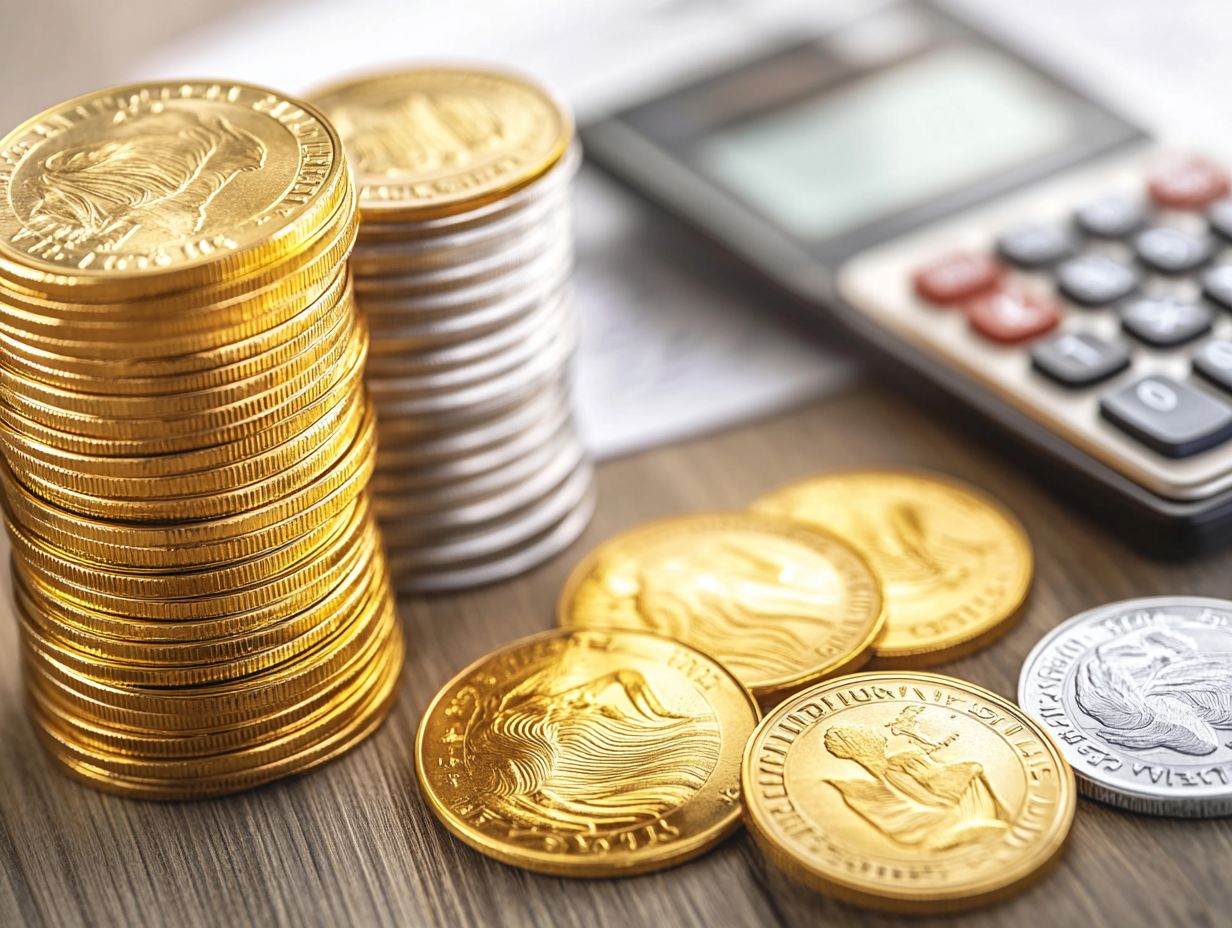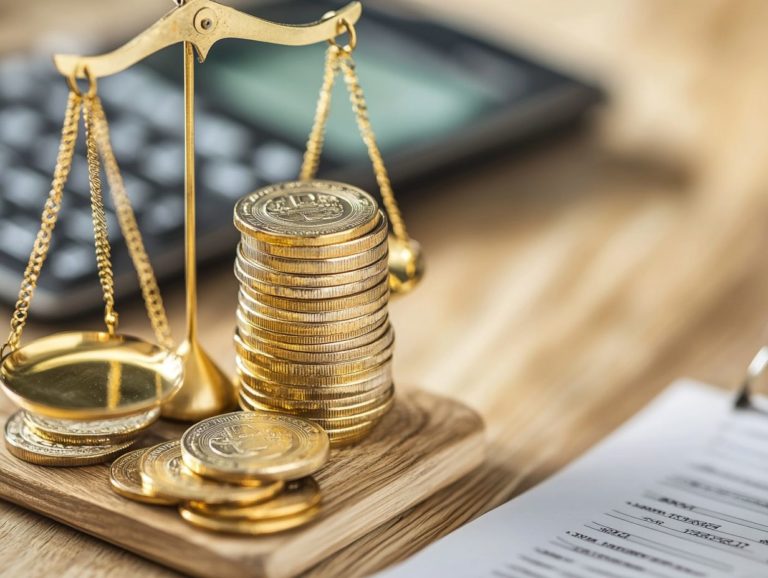Can I Finance Precious Metal Purchases?
Navigating the realm of precious metal financing can be an exhilarating yet intimidating experience. As you look to diversify your portfolio with assets like gold and silver, understanding the benefits and risks tied to financing these purchases is essential.
This article delves into the advantages and potential drawbacks of various financing options, providing a comparison between traditional bank loans and alternative methods. It also highlights key factors you should consider before making a decision.
Whether you’re a seasoned investor or just starting out, this guide will empower you to make informed choices in precious metal financing.
Contents
- Key Takeaways:
- Benefits and Risks of Financing
- Types of Financing Options
- Factors to Consider Before Financing
- How to Finance Precious Metal Purchases
- Frequently Asked Questions
- Can I Finance Precious Metal Purchases?
- What types of precious metals can I finance?
- How much can I finance for precious metal purchases?
- What are the typical interest rates for financing precious metals?
- Do I need good credit to finance precious metals?
- Are there risks associated with financing precious metal purchases?
Key Takeaways:

- Financing precious metal purchases can provide advantages such as flexibility and immediate access to the metal, but also potential drawbacks including high-interest rates and collateral requirements.
- Traditional bank loans and alternative financing methods, such as credit cards or pawn loans, are available for financing precious metal purchases.
- Before committing to financing, consider factors such as interest rates, eligibility requirements, and the overall cost of the financing option in relation to the value of the metal being purchased.
What is Precious Metal Financing?
Precious metal financing encompasses a range of methods and strategies you can use to secure funding for buying valuable metals like gold, silver, platinum, and palladium. This approach is particularly beneficial for those intent on enhancing their investment portfolios while effectively managing the risks associated with market fluctuations.
In this context, precious metal financing emerges as an essential tool in modern investment strategies, enabling individuals and institutions to protect against inflation and currency devaluation. By exploring options such as loans secured by the metals themselves or engaging in leasing arrangements, you can expand your exposure to these valuable assets and optimize your cash flow.
Historically, precious metals like gold and silver have shown remarkable resilience during economic downturns, making them particularly appealing to risk-averse investors. Therefore, understanding how precious metal financing works is crucial for anyone looking to navigate the often unpredictable financial landscape.
Benefits and Risks of Financing
When considering precious metal financing, seize the opportunity to assess the benefits and risks now! Your financial future depends on it.
The appeal of using precious metals as a safeguard against market volatility and inflation often drives you to explore various financing options, including metal ETFs, bullion loans, and considerations regarding credit risk.
Advantages of Financing Metal Purchases
Financing your metal purchases can offer numerous advantages that may significantly enhance your financial security and overall investment portfolio, especially during times of economic uncertainty.
By utilizing financing tools, you can buy physical gold, silver, platinum, or palladium without the burden of immediate upfront costs. This approach not only improves your cash flow management but also increases your purchasing power in the commodity markets.
By embracing this method, you facilitate the buying of tangible assets while encouraging better asset diversification within your portfolio. Investing in various precious metals allows you to spread your risk across different asset classes, which is essential in an unpredictable economic climate.
The strategic use of financing paves the way for improved risk management. It enables a balanced allocation of your resources.
Integrating metals into your investment strategy through financing can significantly bolster your financial resilience, providing a robust protection against inflation and market volatility.
Potential Drawbacks
While financing precious metal purchases presents enticing benefits, it also carries potential drawbacks that you must carefully weigh. This is particularly true concerning investment risks and repayment obligations.
Credit risk is a formidable challenge. If market conditions take a turn for the worse, you may struggle to meet payment schedules, which could lead to significant financial strain. Different financing options come with varying terms, and grasping these intricacies can profoundly influence your long-term investment strategies. For example, fluctuating interest rates might chip away at your projected profits or even exacerbate losses.
You must also consider storage costs for physical assets in your budget. These costs add layers of complexity to your financial picture. Ultimately, these considerations determine whether you feel confident in your decision to invest in precious metals, making an informed analysis of all financial implications absolutely essential.
Types of Financing Options

Exploring the various financing options available for precious metal purchases is vital for making informed investment decisions. Different methods cater to distinct financial needs and objectives, allowing you to tailor your approach.
Traditional bank loans offer a structured pathway. Alternative financing methods like metal ETFs and bullion loans present unique advantages that can enhance your liquidity and flexibility, all while managing market risks effectively.
Traditional Bank Loans
Traditional bank loans are among the most prevalent options for financing the purchase of precious metals. They offer structured terms and dependable creditor obligations for you as a borrower. These loans often come with fixed or variable interest rates. This enables you to allocate funds toward acquiring physical gold, silver, platinum, or palladium while thoughtfully considering the overall impact on your investment portfolio.
It’s important to understand how to apply for these loans. Typically, the procedure begins with submitting an application that includes your financial statements, credit history, and details about the intended purchases.
Lenders will assess eligibility criteria such as your creditworthiness and income stability before approving the loan. Interest rates can vary based on factors like your credit score and prevailing market conditions, directly affecting the cost of financing. By ensuring you have a strong financial profile, you can secure better terms. Therefore, it is vital to prepare thoroughly and explore all options available within traditional banking frameworks.
Alternative Financing Methods
Alternative financing methods for purchasing precious metals present unique solutions tailored to your diverse investment needs. They offer flexibility and innovative payment options. Metal ETFs and bullion loans stand out as popular choices for those wishing to navigate the complexities of traditional loans while still gaining exposure to gold, silver, platinum, and palladium markets.
These alternatives not only simplify the process of acquiring precious metals but also enhance your liquidity and ways to spread your investments. For example, metal ETFs allow you to gain shares in a fund that holds physical metals, making trading effortless while sidestepping the costs of storage and insurance. Similarly, bullion loans enable you to leverage your existing metal holdings to secure funds for other investments, ensuring your portfolio remains robust.
By embracing these financing strategies, you can elevate your investment approach. This allows you to access both immediate capital and long-term growth potential in a dynamic market.
Factors to Consider Before Financing
Before you pursue financing options for your precious metal purchases, it’s essential to meticulously evaluate several critical factors that could significantly impact your investment profile and financial outcomes.
- Interest rates
- Eligibility requirements
- Repayment schedules that should align with your individual investment strategies and risk tolerance
Taking the time to assess these elements can enable you to make informed decisions that enhance your investment experience.
Start exploring your financing options today!
Interest Rates and Terms
Understanding interest rates and financing terms is essential for you as an investor considering precious metal purchases. These elements profoundly influence your overall costs and investment risks. Fluctuations in rates can alter repayment schedules, which may affect your ability to maintain financial security during turbulent market periods.
The total cost of financing isn t just about the interest rate; it also includes various fees and conditions tied to borrowing. That’s why it’s crucial for you to dig deep into the specifics provided by different lenders.
By comparing terms like grace periods, prepayment penalties, and Annual Percentage Rate (APR) you can uncover more advantageous financing options that align with your investment strategies. Grasping how these rates can change over time allows for improved planning and risk management.
Making informed decisions about financing can significantly enhance your investment outcomes, especially in unpredictable markets.
Eligibility and Requirements

When you re seeking financing for precious metal purchases, grasping eligibility and requirements is crucial to navigate the process smoothly. Lenders typically evaluate various factors like credit risk, income documentation, and investment history to determine your eligibility for investor loans and financing options.
Your debt-to-income ratio (the amount of your monthly debt payments compared to your income) and financial health greatly influence your chances of securing favorable terms. To enhance your approval odds, concentrate on improving your credit score by:
- Paying down existing debts,
- Ensuring timely payments,
- Maintaining a healthy mix of credit types.
Providing comprehensive documentation, such as proof of income and a detailed investment strategy, can help establish your credibility with lenders, ultimately paving the way for more favorable financing conditions when purchasing precious metals.
How to Finance Precious Metal Purchases
Financing your precious metal purchases involves key steps that can transform your experience. Ready to dive in? By grasping the available options, preparing the necessary documentation, and assessing your payment methods, you can adeptly manage your financial resources while acquiring valuable assets.
Step-by-Step Guide
A step-by-step guide to financing your precious metal purchases can transform the process into a streamlined experience, enabling you to make strategic decisions that align perfectly with your financial goals. This guide highlights essential phases, including research, preparation of documentation, and the evaluation of financing options tailored specifically to your investment profile.
Starting with thorough research, you can explore various financing avenues, such as personal loans, credit lines, or even specialized funding from bullion dealers. Gathering the necessary documentation is equally crucial; this may involve compiling financial statements, proof of income, and credit history to present a robust application to lenders.
Once you’ve completed these preliminary steps, it s time to assess the different agreements available. This includes comparing interest rates, terms, and conditions from multiple sources, ensuring that your chosen financing solution complements your investment strategy without placing undue strain on your finances.
Frequently Asked Questions
Can I Finance Precious Metal Purchases?
Yes, it is possible to finance precious metal purchases. Many banks and financial institutions offer loans specifically for buying precious metals.
What types of precious metals can I finance?

You can finance a variety of precious metals, including gold, silver, platinum, and palladium. Some lenders may also offer financing for other metals such as rhodium or copper.
How much can I finance for precious metal purchases?
You can finance the full value of precious metals or a portion, depending on the lender. Your credit score plays a crucial role in this process.
What are the typical interest rates for financing precious metals?
Interest rates vary widely. Compare rates from different lenders to find the best deal for you.
Do I need good credit to finance precious metals?
Good credit helps secure better rates. Some lenders may still offer financing to those with less-than-perfect credit.
Are there risks associated with financing precious metal purchases?
Yes, there are risks. Carefully review the loan terms and ensure you’re comfortable with the repayment plan before proceeding.













